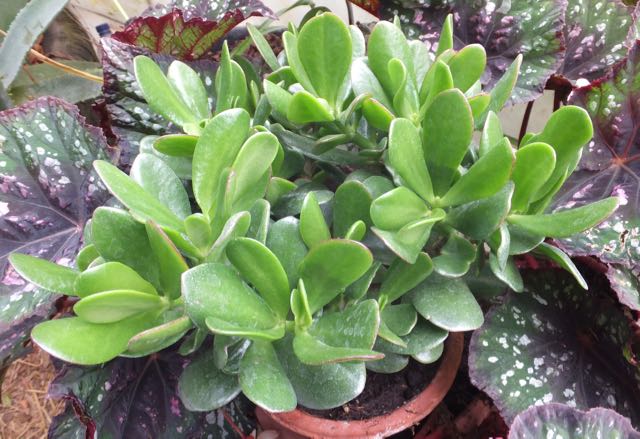
I can’t think of another glasshouse plant that suffered from such perverse name changes as this, one of the oldest of all our houseplants now known as the Jade plant.
A tender succulent from Natal in South Africa this became popular way before the Victorian era. Probably because it’s remarkably tough and undemanding as a houseplant, and slow growing so seldom needs re-potting or giving more space though ‘back home’ it can reach ten foot tall, eventually.
The Jade plants Latin name is Crassula ovata, a genus with six dozen or more rather similar members, once known as Turgosias. (I’m not sure which of these names leads to worse puns.) It was long named C. argentea though perversely this species was then sold as ‘arborescens’ whereas the real C. arborescens (similar but with larger leaves) was sold as ‘argentea’. And most bizarrely, for a succulent Stonecrop closely related to the salad herb Purslane, from South Africa, its first common name was the Japanese Rubber Tree, for goodness knows what reason at all.
One variety gave it’s name to the rest of the genus which are still sometimes called Silver Dollar plants, which does sort of describe some of the more rounded leafed forms. This resemblance in shape to worn pieces of fat coin is likely why it also became known as the Money Plant, or maybe this was just shrewd marketing suggesting it bringing financial luck… Now though most of us know this Crassula as the Jade Plant, for the green translucency of the swollen leaves does indeed resemble Jade.
But unlike money you can plant these and get new ones, any piece will root easily (dry the pieces for three days before setting). Growing from seed is theoretically possible, these do flower though not very dramatically. However there so many delightful variants, coloured, variegated and with a huge variety of leaf size and shape it’s simpler, and quicker, to purchase the forty or so choice varieties already available.
As I said, these are remarkably tough, your only likely problem will be over-watering or over-feeding. These enjoy poor sandy gritty free draining composts, and an unglazed terra cotta pot. (As much to balance the weight of the top as for other reasons.) A sunny position suits best. Other than that just wipe the leaves occasionally as these collect dust and water marks.


